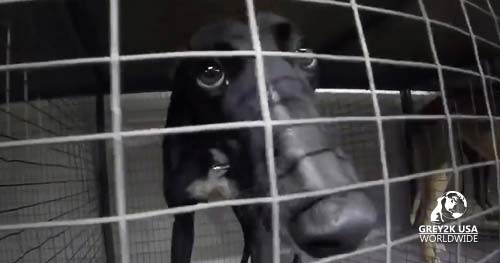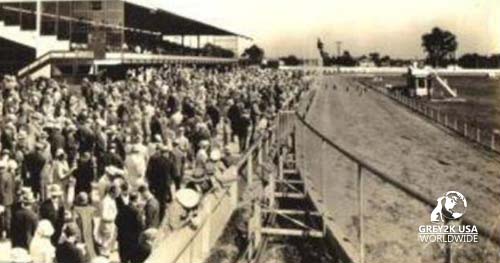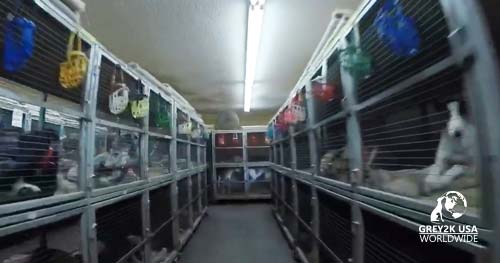 |
| A caged greyhound at Orange Park Kennel Club |
By Christine A. Dorchak, President and General Counsel of GREY2K USA Worldwide
History awaits
the greyhounds this fall. On Election Day, the voters of Florida will have the
opportunity to turn back the hands of time and end dog racing in its most
established state. As many as 8,000 lucky greyhounds stand to receive the
second chance they deserve, closing out nearly 100 years of exploitation and
cruelty.
The first
recognized commercial greyhound racetrack in the world was opened in 1919 in
California. The Blue Star Amusement Park had an oval track and featured a new
invention called the mechanical lure. Created by Owen Patrick Smith, the device was
intended to offer a more humane alternative to the traditional use of live
rabbits in field coursing. By 1930, sixty-seven "flapping" tracks had opened and closed all across
the United States – none of them legal. A bid to force approval of dog racing in
Kentucky was brought before the U.S. Supreme Court in 1927, but failed. No
state would authorize this new business, even during the height of the Great
Depression.
But Florida was
different. It became the first state to allow dog tracks to operate legally –
as long as it received a piece of the action. In 1931, Sunshine State lawmakers
passed a racing bill over Governor Doyle E. Carlton’s veto. By 1935, there were
ten licensed tracks in operation, some controlled by known
criminals such as Meyer Lansky. Oregon and Massachusetts became the next states
to authorize dog racing, in 1933 and 1934 respectively. Although church groups,
civic and humane organizations rallied in opposition, the new industry of
greyhound racing continued to grow and was legalized in a total of nineteen
states by 1989.
 |
| Greyhounds racing at the Tampa race track |
Referred to as
the “Sport of Queens,” perhaps in reference to Queen Elizabeth I’s promotion of
greyhound coursing in the sixteenth century, dog racing sought to promote
itself as elite, glamorous and a good time for all, including the greyhounds themselves.Proponents of
dog racing in Florida were perhaps the most enthusiastic of all in emphasizing
the “sun and fun” to be had at its facilities. Old time movie heartthrobs,
entertainers and sports figures such as Joe DiMaggio, Babe Ruth, Janet Leigh
(star of Alfred Hitchcock’s “Psycho”) and even Old Blue Eyes himself, Frank
Sinatra, made multiple appearances at dog tracks in the Sunshine State. In
1958, Sinatra filmed a movie about a dog track gambler at the Flagler Kennel
Club and one year later, he appeared on the cover of the Greyhound Racing Record along with a woman newly crowned as the
“Queen of American Greyhound Racing.” Photographed with them was the winning
dog in a race named after the famous singer.
Those days are
long gone and the truth about dog racing has now been revealed in official state documents, financial reports and testimony from dog track workers themselves. Kept in warehouse style kennels, in rows of stacked metal cages for
20-23 hours a day, the dogs are fed a diet based on raw, diseased meat. When
let out of their cages to race several times a month, they face the risk of
serious injury. Broken legs, crushed skulls, snapped necks, paralysis and heat
strokes are common. Some dogs have even been electrocuted while racing.
According to information gathered by the state’s Division of Pari-Mutuel
Wagering, a greyhound dies every three days at Florida’s eleven racetracks.
Cheating is
another hallmark of this industry. Over the past decade, there have been 419
greyhound drug positives, including 68 cocaine positives. Greyhounds have also
been found with pain killers and opiates like novocaine and oxymorphone in their
systems. Females are routinely given anabolic steroids to build
muscle and prevent loss of race days during their heat cycles, a practice which
triggers both animal welfare and race fixing concerns.
 |
| Caged greyhounds at the Sanford Orlando Kennel Club |
Thankfully, dog
racing is now illegal in 40 states and since 1990, the amount of money wagered
on dog racing in the Sunshine State has plummeted by 74%. Tax revenue has
declined by 98% and the tracks themselves now lose a combined $34 million. If
it were not for a state mandate requiring racetracks to offer a minimum number
of races as the platform for other, more popular forms of gambling, this
antiquated activity would have ended long ago. Until it does, the state will
continue to waste as much as $3.3 million per year regulating a dying
industry.
Statewide
polling shows that Florida voters will vote to end dog racing if they are fully
informed about its humane and economic problems. You can help the greyhounds by
learning learn more
about Amendment 13 and by spreading
the word that it’s time to
set the greyhounds free.

No comments:
Post a Comment